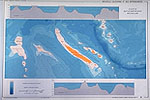 Garden Home |
Research Home
Garden Home |
Research Home Garden Home |
Research Home
Garden Home |
Research Home Map of New Caledonia (source: Atlas de la Nouvelle-Calédonie. ORSTOM, Paris).
Map of New Caledonia (source: Atlas de la Nouvelle-Calédonie. ORSTOM, Paris).
The Territory of New Caledonia can be divided into the following geographically distinct entities:
Essentially all of New Caledonia's botanical diversity is concentrated on Grande Terre. The smaller islands have depauperate, relatively species-poor floras; even the Loyalty Islands have less than 400 species (Jaffré, 1993), representing only a minor sub-set of the diversity occurring on the main island, having been established relatively recently through long-distance dispersal from Grande Terre, and to a much lesser degree from other areas such as Vanuatu (formerly the New Hebrides). Only a few locally endemic species occur on the smaller islands, such as the palmCyphophoenix nucele, which is restricted to a single population on Lifou (cf. MacKee et al., 1985; Jaffré and Veillon, 1989), and no unique vegetation types occur in these areas. Because the younger surrounding islands are of limited interest botanically, only Grande Terre will be taken into consideration below.